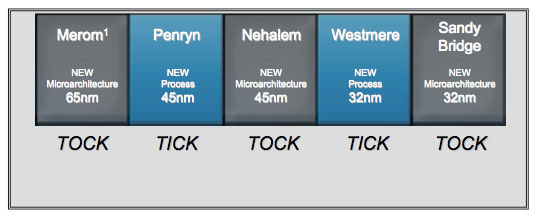Nehalem - Everything You Need to Know about Intel's New Architecture
by Anand Lal Shimpi on November 3, 2008 1:00 PM EST- Posted in
- CPUs
This is Ronak Singhal, he works for Intel, say hello:

He’s kind of focused on the person speaking in this situation, but trust me, he’s a nice guy. He also happens to be the lead architect on Nehalem.
Nehalem of course is the latest microarchitecture from Intel, it’s a “tock” if you’re going by Intel’s tick-tock cadence:

It’s a new architecture, at least newer than Penryn, but still built on the same 45nm process that debuted with Penryn. Next year we’ll have the 32nm version of Nehalem called Westmere and then Sandy Bridge, a brand new architecture also built on 32nm. But today is all about Nehalem.
Recently Intel announced Nehalem’s branding: the Intel Core i7 microprocessor. I’ve asked Intel why it’s called this and so far the best response I can get is that the naming will make sense once the rest of the lineup is announced. Intel wouldn’t even let me know what the model numbers are going to look like, so for now all we’ve got is that it’s called the Core i7. I’ll use that and Nehalem interchangeably throughout the course of this article.










35 Comments
View All Comments
defter - Friday, August 22, 2008 - link
Links are 20-bit wide, regardless of encoding or whether 1,2,8,16 or 20 bits are used to tranmist the data.I wonder who is flamebaiting here, a previous poster just mentioned the correct link width, he wasn't talking about "usable speed".
rbadger - Thursday, August 21, 2008 - link
"Each QPI link is bi-directional supporting 6.4 GT/s per link. Each link is 2-bytes wide..."This is actually incorrect. Each link is 20 bits wide, not 16 (2 bytes). This information is on the slide posted directly below the paragraph.
JarredWalton - Thursday, August 21, 2008 - link
It's 20-bits but using a standard 8/10 encoding mechanism, so of the 20 bits only 16 are used to transmit data and the other four bits are (I believe) for clock signaling and/or error correction. It's the same thing we see with SATA and HyperTransport.ltcommanderdata - Thursday, August 21, 2008 - link
Since the PCU has a firmware, I wonder if it will be updatable? It would be useful if lessons learn in the power management logic of later steppings and in Westmere can be brought back to all Nehalems through a firmware update for lower power consumption or even better performance with better Turbo mode application. Although a failed or corrupt firmware update on a CPU could be very problematic.wingless - Thursday, August 21, 2008 - link
I thought about this when I read about it the first time too. Flashing your CPU could kill the power management or the whole CPU in one fell swoop!